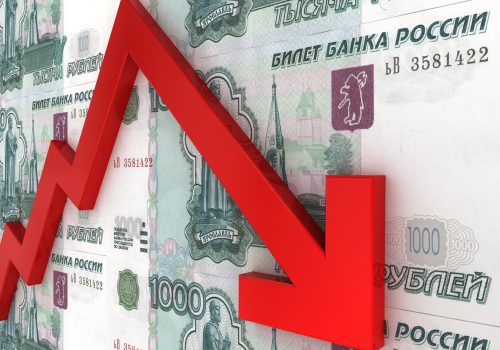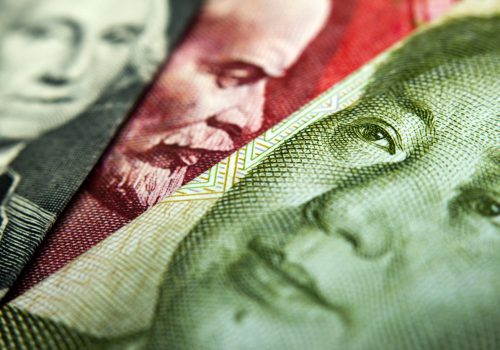The United States, European Union, and United Kingdom surprised almost everyone this week by sanctioning the Central Bank of Russia (CBR). By freezing the bank’s assets in their jurisdictions, Western allies hope to deprive Moscow of one of the key planks of its “Fortress Russia” self-reliance strategy: the CBR’s $630 billion stockpile in reserves.
Over the past six days, the CBR has innovated quickly to keep the largest possible set of monetary policy tools, including foreign currency buffers, at its disposal. But this has also forced it to break taboos—from capital controls and closed stock markets to allowing banks to hold off on re-valuating their assets. That’s why the bank could quickly run out of options as sanctions begin to bite and the credit market seizes up.
Although authorities have declared every working day since Monday a bank holiday, the ruble has still fallen to new lows in currency markets. As I predicted last week, the main response of the CBR has been to slam up interest rates, rather than to intervene directly in the foreign exchange market. I did not predict that sanctions would severely curtail its ability to do so anyway.
A key underreported factor in this crisis has been that the CBR hasn’t had the mandate to stick to a particular exchange-rate peg or corridor since late 2014. At that time, Russia was battling falling oil prices and fresh sanctions following its annexation of Crimea. It became clear that even a large stockpile of reserves was finite and couldn’t be used to prevent depreciation indefinitely. Ever since, the bank’s core mandate has been to keep inflation in check and oversee a healthy domestic credit market via an independent interest-rate policy.
Granted, sanctions and the resulting depreciation weaken the bank’s ability to fulfill these priorities too. Inflation was already well above the 4 percent target and will be further accelerated by the ruble’s sudden depreciation. Domestic banks and corporations also have dollar-denominated liabilities and rely on the CBR to supply them with dollar liquidity as well as rubles.
The CBR has dealt with many challenges since the global financial crisis—but it has never lent out more than what it had backed up in foreign exchange and other safe assets, even in emergency lending. Now, with a conservative estimate of 53 percent of its assets frozen and the central bank unable to buy swaps from Western banks, the CBR could suddenly look much less credible as a lender of last resort.
In just a week, its claims on banks have quintupled to 5.2 trillion rubles, or 20 percent of its available reserves—and this assumes the $130 billion of gold reserves it holds are liquid, when they are in fact hard to move and not really in demand. Expect emergency lending to grow over the coming days and weeks, as markets re-open and the new sanctions begin to bite.
While nothing prevents the CBR from lending more rubles than it can access in foreign exchange, its goal in a high-inflation environment is to use the money it has wisely. It must also deal with a currency mismatch problem, since Western banks won’t provide swaps. The Peoples’ Bank of China does have a swap line with CBR, but only for the renminbi. Chinese state banks have also shown reluctance to finance the purchase of Russian commodities in dollars, so they are unlikely to offer dollar swaps.
The measures announced by CBR Governor Elvira Nabiullina since Monday combine emergency lending with more innovative policies. To keep bank balance sheets looking healthy, the CBR has effectively stopped the clock by allowing them to not update their asset valuations to reflect the latest market turmoil. To ensure the CBR still has enough dollars to lend to the banking system, the bank is forcing exporters to convert 80 percent of their revenue into rubles. It is also stemming the flow of foreign exchange leaving the country by limiting non-residents’ ability to withdraw capital and Russians’ ability to take cash across the border.
The government has also introduced a set of policies to support the CBR’s effort to substitute frozen reserves. The Finance Ministry has introduced a “capital amnesty” allowing residents with savings abroad to bring them back to Russia with few questions asked about taxes or criminal activity. On March 1, Prime Minister Mikhail Mishustin announced a temporary ban on foreign investors selling their Russian assets. And in a subsequent announcement, the CBR banned the transfer of coupon payments to foreign owners of ruble bonds.
Missing interest payments takes Russia very close to sovereign default territory, but doesn’t quite cross the line.
Naturally, these emergency policies will damage Russia’s long-term attractiveness for investors—but that’s hardly a political priority now. The CBR did not expect to be sanctioned so quickly, and clearly was forced to prepare its response in a hurry, without having the time to think through the long-term implications for its frozen reserves. The United States and its partners haven’t yet set out any conditionality for the new sanctions to be lifted. They’re hoping that economic pressure will force Russia to pull back its troops.
At the CBR, at least, that pressure is showing.
Charles Lichfield is the deputy director of the Atlantic Council’s GeoEconomics Center.
Further reading
Mon, Mar 7, 2022
Global Sanctions Dashboard: Special Russia edition
EconoGraphics By
Sanctioning Russian Central Bank, cutting Russia off SWIFT, and Russia’s options for sanction-proofing its economy.
Fri, Feb 18, 2022
Russia and China: Partners in Dedollarization
Econographics By Mrugank Bhusari, Maia Nikoladze
Russia has virtually stopped receiving Dollars for its exports to China. Does the US have reason to be concerned?
Thu, Feb 24, 2022
The global economy will suffer from Russia sanctions, but not for long
New Atlanticist By Hung Tran
Russia’s modest contribution to the global GDP means the world’s economic pain will pass even though the fallout of the invasion will define geopolitics for years.
Image: Russian presidential aide Maxim Oreshkin, right, and Russian Central Bank Governor Elvira Nabiullina, left, attend a meeting on economic issues held by Russian President Vladimir Putin in Moscow on February 28. Photo by Alexei Nikolsky/Russian Presidential Press and Information Office/TASS via REUTERS



